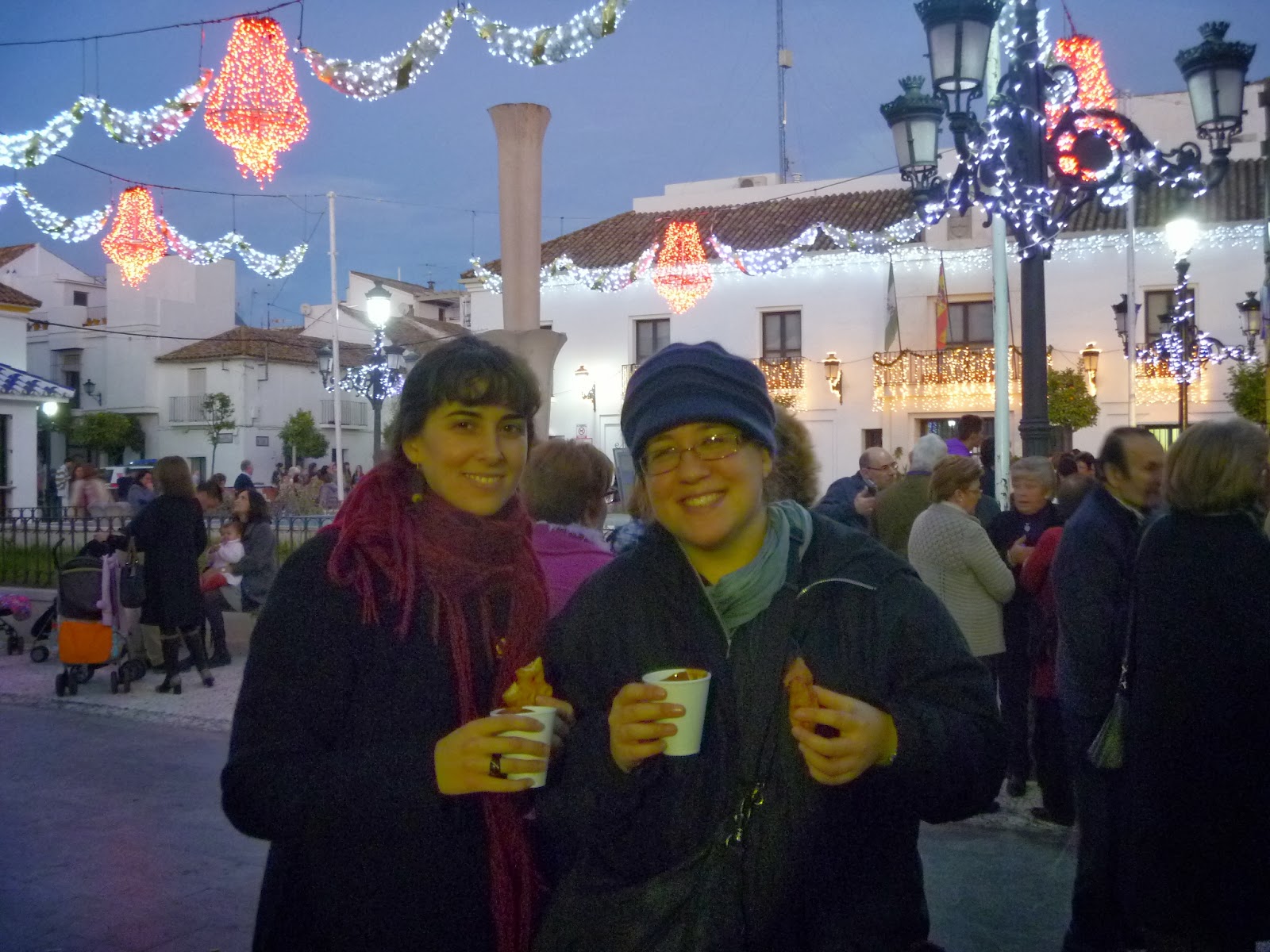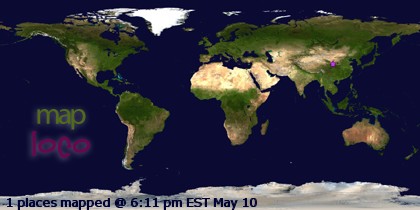 |
| Plaza San Francisco, Linares, all decked out |
... which is why I was surprised to realize I have never written anything in depth about these traditions, especially when there are so many interesting ones. Since I am anticipating that this year will mark my last Christmas in Spain for awhile, now seems an excellent time to correct this egregious error:
The Christmas season starts more or less officially in Spain during the first week of December, specifically at Candelaria on December 8. Around that time, Christmas lights and other decorations go up throughout the country, from the most elaborate in Madrid to the most simple in tiny Huelva villages. In my five Spanish Christmases, I have concluded that Christmas lights in Spain are of a very specific style. Unlike in the US, where strings of white or multicolored lights and tacky neon reindeer rule, Spanish lights are hung from cables that crisscross streets and boulevards, creating bold, blocky patterns or loop-de-loops that are very distinct from the American-style.
 |
| Typical Christmas lights hang on a street in Cadiz |
The hanging of lights is often accompanied by installation of a Christmas market in the town square or one of the city plazas. Although Christmas trees are becoming more popular as American and British traditions trickle into Spain, most families still have a carefully-constructed nativity scene in their living rooms to mark the season-- in Andalucia in particular, these can grow to enormous sizes. People devote huge amounts of time and effort to constructing entire tiny Bethlehems, many of which include water features, electric lights, and timed sunrises and sunsets. In Linares, the government sponsored an enormous nativity scene that took up an entire empty store on the shopping street. Given the centrality of the nativity scene, the Christmas markets usually boast a section devoted entirely to selling tiny ceramic wise men, camels, or angels; they also offer decent amount of schlock and, if you're lucky, some respectable arts and crafts. Last year I bought a gorgeous handmade stool crafted from a whole olive-tree stump for 10 euros.
 |
| The nativity scene at my school in Talavera de la Reina |
Traditional Christmastime food differs according to region, but one particular favorite of mine can be found throughout the country: mantecados and polvorónes. Stay with me for a moment here: much like the famous square-rectangle conundrum, polvorónes are mantecados, but not all mantecados are polvorónes (the difference has to do with the specific recipe.) The nonetheless similar sweets are a sort of crumbly shortbread originally introduced by the Moors (ironic, yes?) Interesting fact: later on, the key ingredient was switched to pork fat, and the Inquisition forced detainees to eat the sweets in order to ferret out secret Muslims and Jews (manteca is pork lard in Spanish.) These days, mantecados and polvorónes are most popular in Andalucia but can be found almost literally everywhere during December. They are extremely delicious and terrible for you.
The next morning, when the entire village/city has dragged itself out of bed to drink an espresso and attempt to recover... still Christmas is not over. In Spanish, people refer to "navidades" in plural, and my personal theory is that this is because it is refers more to a "Christmas season" than a single day. Besides Christmas Eve and Day the term also refers to New Year's Eve (nochevieja or "old night"-- no one has ever explained to me why it's called that) and 3 Kings Day. New Year's Eve is celebrated much the same as its Christmas counterpart, with a multi-course all-family meal that lasts until the wee hours. The major difference is a pause at midnight: as the clock strikes 12, families all over Spain endeavor to eat one grape in tandem with each strike of the cathedral clock-- a challenging task, as the grapes here generally have seeds. I'll let my roommate, Judith, explain to you what an impossible task that is: "Every year I try, and every year I end up like a hamster with my cheeks full of grapes, wishing everyone 'Happy New Year'-- and my parents say, 'Judith, don't talk with your mouth full,'" she explained to me cheerfully earlier this month, as we caught up on our Christmas vacations.
And yet, even with the grape ordeal in the past, Navidades is not yet complete-- not until January 6 and the arrival of the Reyes Magos (the figures that Americans know as the three Wise Men but whose names are frequently translated here as the "Magic Kings.") Although Santa Claus has made an appearance in Spanish pop culture in recent years, he is not the beloved bringer of presents that he is elsewhere. Spanish children must wait until the morning of January 6 to see what the three Kings of biblical lore (you know, they followed the star to Bethlehem, or something? Don't ask me, I'm a Jew) brought them. The "Dia de Los Reyes Magos," full of presents and -- you guessed it-- another multi-generational multi-course meal, is preceded on the evening of January 5 by the "cabalgata de reyes magos," an elaborate procession-cum-parade through the streets announcing the arrival of the Kings. Virtually every community in the country, from the smallest town to the largest metropolis, hosts its own cabalgata, usually featuring Disney characters with oversized heads, some of whom arrive on horseback. The cabalgata in Madrid is largely agreed to be the most impressive, including a great many floats; public opinion generally has it that the quality of other cabalgatas has waned dramatically throughout the country with the onset of the economic crisis. Still, crisis or no, the cabalgata is a must for every under-15 child in town, seeing as every parade includes some frankly intense levels of candy throwing. I know of children who bring umbrellas to turn upside down in order to catch a maximum quantity of sweets.
 |
| Christmas in the white villages of Cadiz; hot chocolate in the town square of Prado del Rey |
And yet, even with the grape ordeal in the past, Navidades is not yet complete-- not until January 6 and the arrival of the Reyes Magos (the figures that Americans know as the three Wise Men but whose names are frequently translated here as the "Magic Kings.") Although Santa Claus has made an appearance in Spanish pop culture in recent years, he is not the beloved bringer of presents that he is elsewhere. Spanish children must wait until the morning of January 6 to see what the three Kings of biblical lore (you know, they followed the star to Bethlehem, or something? Don't ask me, I'm a Jew) brought them. The "Dia de Los Reyes Magos," full of presents and -- you guessed it-- another multi-generational multi-course meal, is preceded on the evening of January 5 by the "cabalgata de reyes magos," an elaborate procession-cum-parade through the streets announcing the arrival of the Kings. Virtually every community in the country, from the smallest town to the largest metropolis, hosts its own cabalgata, usually featuring Disney characters with oversized heads, some of whom arrive on horseback. The cabalgata in Madrid is largely agreed to be the most impressive, including a great many floats; public opinion generally has it that the quality of other cabalgatas has waned dramatically throughout the country with the onset of the economic crisis. Still, crisis or no, the cabalgata is a must for every under-15 child in town, seeing as every parade includes some frankly intense levels of candy throwing. I know of children who bring umbrellas to turn upside down in order to catch a maximum quantity of sweets.
From there, I guess you can imagine the rest. Keyed up children, zooming around the house powered by candy overdose; comatose post-sugar crash kids heading sleepily to bed; those same tykes waking at an ungodly hour to see what the Kings have brought (this year they brought me my very own marker/crayon/colored pencil set, complete with pencil case-- there is so much coloring in my future!). And then, once the presents have been opened, the three-course lunch consumed, the last drop of coffee drunk... only then is navidades finished...
... until the next day, when rebajas (enormous city-wide after-Christmas sales) begin, of course.
 |
| Christmas lights by the ancient wall in Talavera. I am unsure what special effect I accidentally engaged to make them twinkle like that, but I don't mind. I kind of like it. |

